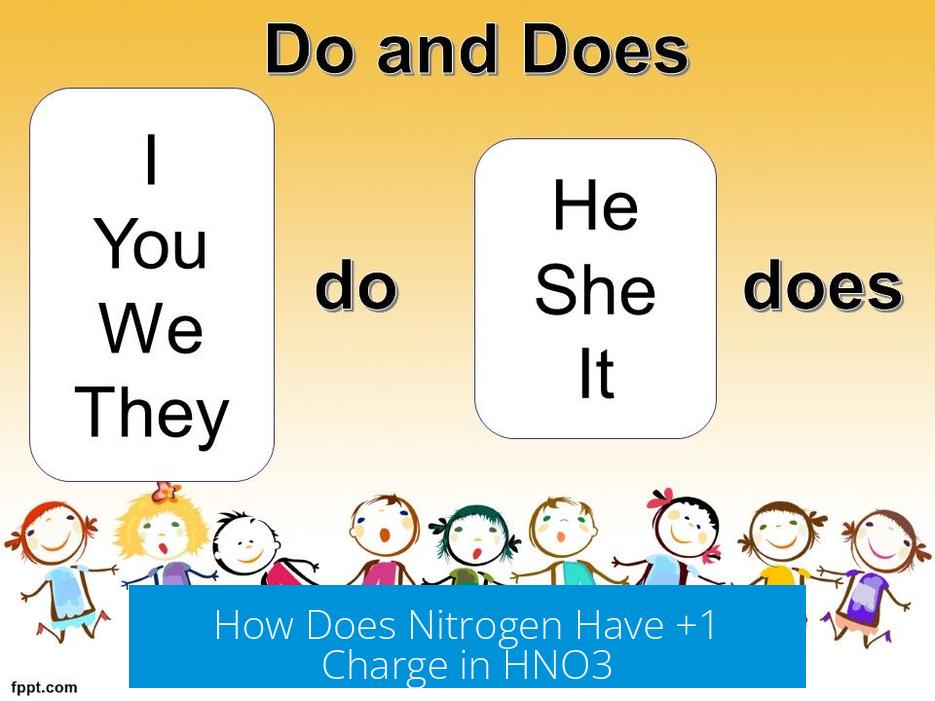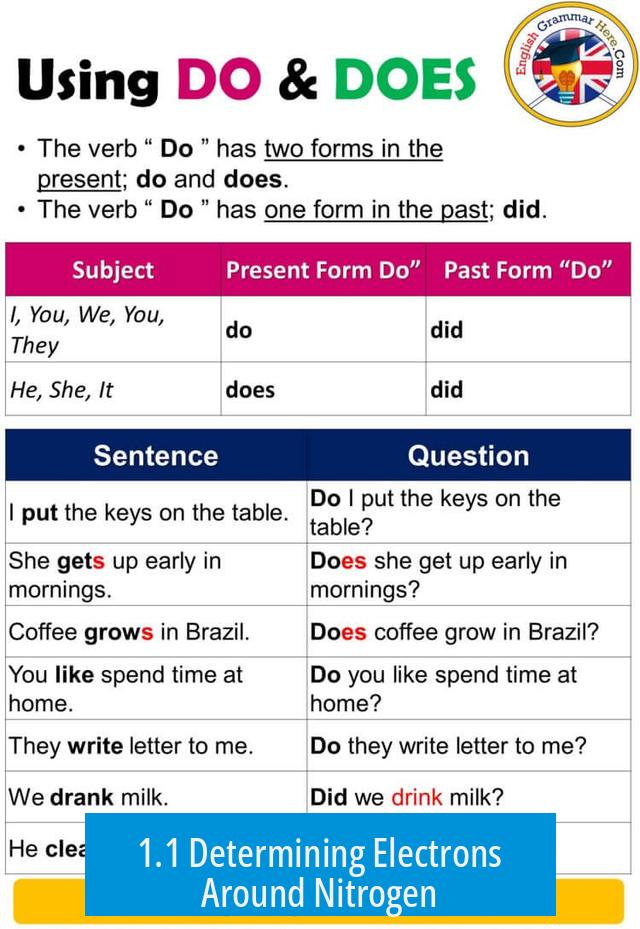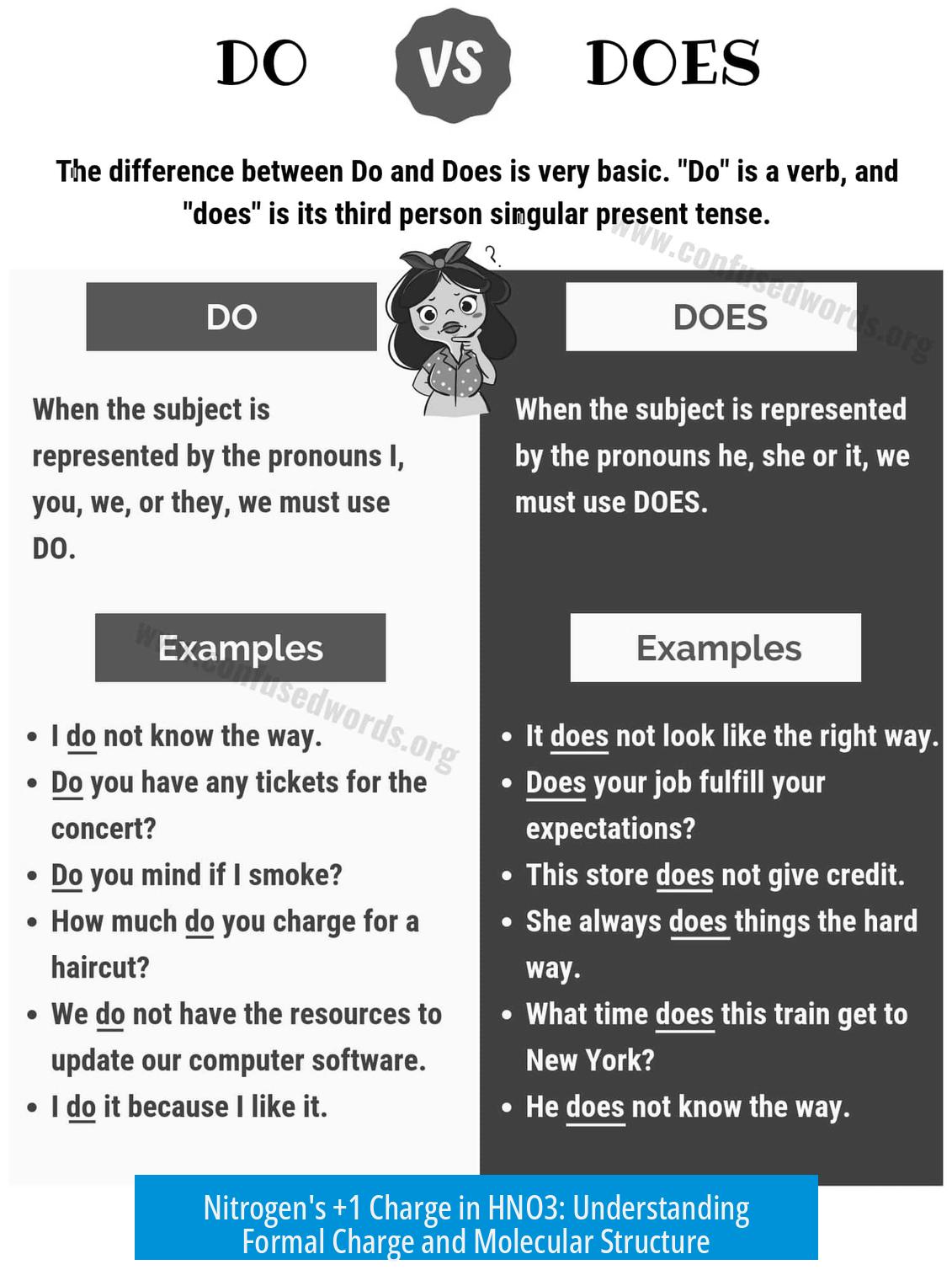How Does Nitrogen Have +1 Charge in HNO3?

Nitrogen in nitric acid (HNO3) carries a formal charge of +1 because it forms four covalent bonds, effectively “owning” one less electron than its neutral valence state of five. This electron deficit results in a +1 formal charge on the nitrogen atom. However, the nitrogen’s oxidation state in HNO3 is +5, reflecting the complete transfer of bonding electrons toward more electronegative oxygen atoms. Resonance structures in the molecule delocalize charge, so the positive charge is not localized solely on nitrogen.
1. Understanding Formal Charge: The Basis for Nitrogen’s +1 Charge
1.1 Determining Electrons Around Nitrogen

Nitrogen belongs to group 15 and has 5 valence electrons in its neutral atomic state. In HNO3, nitrogen bonds to three oxygen atoms: one forms a double bond with nitrogen, while the other two form single bonds. Specifically, the nitrogen to oxygen bonding consists of:
- One double bond (one sigma and one pi bond) to an oxygen atom
- Two single sigma bonds to the other oxygens
This means nitrogen participates in four sigma bonds total, equivalent to four “shared” bonding electron pairs.
1.2 Formal Charge Calculation
The formal charge calculation assumes electrons in each bond are shared equally between the bonded atoms. Counting the electrons nitrogen “owns”:
- Each bond contributes one electron to nitrogen’s count
- Nitrogen “owns” 4 bonding electrons
- Neutral nitrogen atom has 5 valence electrons
Because nitrogen has one fewer electron than it starts with, its formal charge is:
Formal charge = (Valence electrons) – (Nonbonding electrons + 1⁄2 Bonding electrons)
Here:
- Valence electrons = 5 (for nitrogen)
- Nonbonding electrons = 0 (no lone pairs on nitrogen)
- Bonding electrons = 8 (4 bonds × 2 electrons each), half to nitrogen = 4
So formal charge = 5 – (0 + 4) = +1
1.3 Analogies for Clarity
Comparisons help illustrate this phenomenon. For example, the hydrocarbonate anion (HCO3−) has carbon as the central atom. When carbon is replaced by nitrogen to form HNO3, nitrogen adopts a +1 formal charge but the overall molecule remains neutral. This is because changes in bonding and electron sharing alter the apparent charges on the central atom.
2. Distinction Between Formal Charge and Oxidation State on Nitrogen
2.1 What Is Oxidation State?
Oxidation state treats electrons in each bond as fully assigned to the more electronegative element. For the nitrogen-oxygen bonds in HNO3, oxygen is more electronegative than nitrogen, so nitrogen “loses” all bonding electrons to oxygen.
Counting nitrogen’s electrons in this way yields an oxidation state of +5. This matches the number of bonds nitrogen has to oxygen atoms minus any electrons nitrogen “owns”. Thus, nitrogen is oxidized to +5 in nitric acid.
2.2 Formal Charge vs Oxidation State Summarized
| Characteristic | Formal Charge | Oxidation State |
|---|---|---|
| Electron Assignment | Electrons shared equally in bonds | Electrons assigned to more electronegative atom |
| Purpose | Electron bookkeeping to formalize Lewis structures | Electron counting to track redox changes |
| Nitrogen in HNO3 | +1 | +5 |
3. Molecular Structure and Resonance Impact on Charge
3.1 Resonance Delocalization
Nitric acid does not have just one fixed Lewis structure. Several resonance forms exist where the placement of double bonds and charges shifts among the oxygen atoms. The positive formal charge on nitrogen is thus delocalized through resonance.
This means the nitrogen’s +1 formal charge is not a localized physical charge but rather an artifact of the chosen resonance form for electron bookkeeping.
3.2 Typical Resonance Structures of HNO3
- Structure A: Nitrogen double bonded to one oxygen, single bonded to two other oxygens (one bearing the hydroxyl group, OH)
- Structure B: The double bond shifts to a different oxygen, moving the formal charge accordingly
- Resulting resonance hybrid distributes charges across oxygen atoms and nitrogen
Referencing a molecular resonance diagram (e.g., from Wikipedia) illustrates that the positive charge is spread out and not solely on nitrogen.
4. Clarifications on Charge Types and Distribution
4.1 Differentiating Formal Charge, Oxidation Number, and Atomic Charge
These three concepts often cause confusion:
- Formal Charge—an electron counting tool based on equal sharing of bonding electrons
- Oxidation Number—a hypothetical charge assuming complete electron transfer to electronegative atoms
- Atomic Charge—real charge distribution based on quantum mechanical electron density (varies continuously)
In nitric acid, the actual positive charge density tends to reside more on the hydrogen atom connected to oxygen. This hydrogen is slightly positive due to its bond to oxygen, which is highly electronegative.
4.2 Charge Distribution in HNO3
The oxygen atoms bear the bulk of the negative charge, consistent with their high electronegativity. Nitrogen is somewhat positive but less so than hydrogen.
So, while nitrogen formally carries a +1 charge in electron bookkeeping, it is not the principal positively charged site responsible for chemical reactivity.
Summary of Key Points
- Nitrogen in HNO3 forms four covalent bonds but “owns” only four electrons, one less than its valence count of five, resulting in a +1 formal charge.
- The oxidation state of nitrogen in nitric acid is +5, reflecting electron assignment to oxygen.
- Resonance delocalizes charge through the molecule; the positive charge is not localized on nitrogen alone.
- Formal charge is a bookkeeping tool, different from oxidation state and actual atomic charge distribution.
- The hydrogen atom bonded to oxygen carries the most positive character in HNO3.
Why does nitrogen in HNO3 have a formal charge of +1?
Nitrogen forms four covalent bonds and effectively “owns” 4 electrons. It normally has 5 valence electrons, so it’s missing one electron. This electron deficit gives nitrogen a formal charge of +1 in HNO3.
How is formal charge on nitrogen different from its oxidation state in HNO3?
The formal charge is +1 because of equal electron sharing in bonds. The oxidation state is +5, as electrons in bonds are assigned to more electronegative atoms. They represent different ways to account for electrons.
How does resonance affect the charge on nitrogen in nitric acid?
Resonance in HNO3 spreads out the positive charge across oxygen atoms. This means the +1 charge on nitrogen is not localized but delocalized over the molecule, stabilizing the structure.
Why does nitrogen “want” five electrons in its valence shell?
Nitrogen is in group 15 and prefers having five valence electrons to achieve a stable configuration. In HNO3, it shares only four electrons, causing the formal charge to be +1 for nitrogen.
Can you explain the difference between formal charge, oxidation number, and atomic charge in this context?
Formal charge is a bookkeeping method based on equal electron sharing. Oxidation number allocates electrons to more electronegative atoms, reflecting potential electron loss. Atomic charge refers to the actual physical charge, often spread across atoms.





Leave a Comment